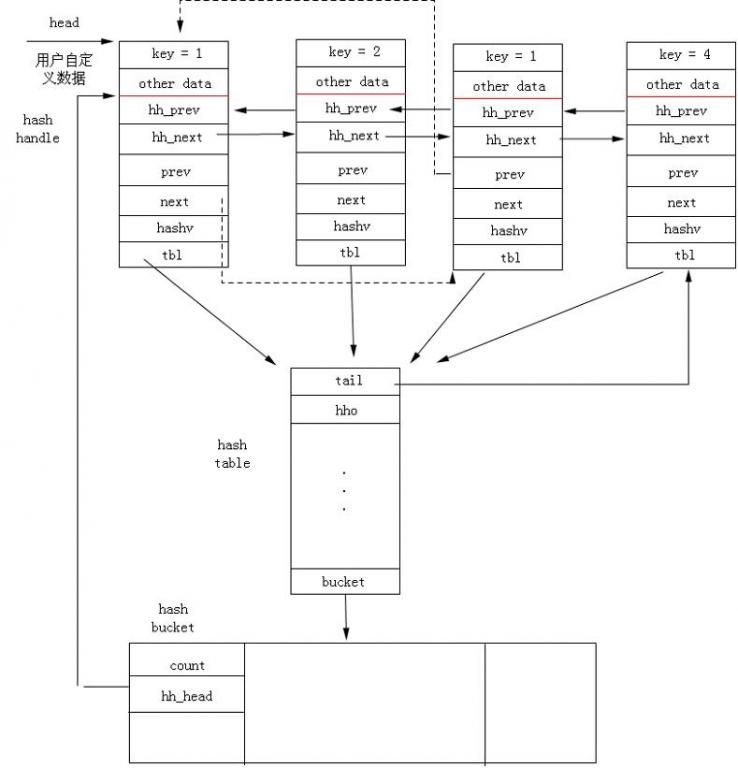简单好用的hash表-----uthash
2024-10-18 09:18:31
在软件开发中,不可不免的会使用到hash表,hash表的优点这里就不说了,以下介绍一个hash表的C实现,
uthash是用宏实现的,使用的时候非常方便,只用包含uthash.h即可。
Uthash的三个数据结构:
typedef struct UT_hash_bucket {
struct UT_hash_handle *hh_head;
unsigned count;
unsigned expand_mult;
} UT_hash_bucket;
UT_hash_bucket作用提供根据hash进行索引。
typedef struct UT_hash_table {
UT_hash_bucket *buckets;
unsigned num_buckets, log2_num_buckets;
unsigned num_items;
struct UT_hash_handle *tail; /* tail hh in app order, for fast append */
ptrdiff_t hho; /* hash handle offset (byte pos of hash handle in element */
unsigned ideal_chain_maxlen;
unsigned nonideal_items;
unsigned ineff_expands, noexpand;
uint32_t signature; /* used only to find hash tables in external analysis */
#ifdef HASH_BLOOM
uint32_t bloom_sig; /* used only to test bloom exists in external analysis */
uint8_t *bloom_bv;
char bloom_nbits;
#endif
} UT_hash_table;
UT_hash_table可以看做hash表的表头。
typedef struct UT_hash_handle {
struct UT_hash_table *tbl;
void *prev; /* prev element in app order */
void *next; /* next element in app order */
struct UT_hash_handle *hh_prev; /* previous hh in bucket order */
struct UT_hash_handle *hh_next; /* next hh in bucket order */
void *key; /* ptr to enclosing struct's key */
unsigned keylen; /* enclosing struct's key len */
unsigned hashv; /* result of hash-fcn(key) */
} UT_hash_handle;
UT_hash_handle,用户自定义数据必须包含的结构。
三种数据结构的关系如下:

说明:
每一个节点(用户自定义的)必须包含一个UT_hash_handle hh
key:用户自定义,可以是int, string和指针。
hh_prev: 指向前一个UT_hash_handle
hh_next: 指向下一个UT_hash_handle
hashv:根据key计算出的hash值
prev: 指向前一个数据节点(Hash冲突时)
next: 指向下一个数据节点(Hash冲突时)
hho: 数据节点中hh于用户节点首地址的差。
uthash使用代码例子
#include "uthash.h"
#include <stdlib.h> /* malloc */
#include <stdio.h> /* printf */
#include <time.h> typedef struct example_user_t {
int id;
int cookie;
UT_hash_handle hh;
} example_user_t; int main(int argc,char *argv[]) {
int i;
example_user_t *user, *users=NULL; srand((unsigned int)time(NULL));
/* create elements */
for(i=;i<;i++) {
if ( (user = (example_user_t*)malloc(sizeof(example_user_t))) == NULL) exit(-);
user->id = rand()%;
user->cookie = i*i;
HASH_ADD_INT(users,id,user);
} for(user=users; user != NULL; user=(example_user_t*)(user->hh.next)) {
printf("user %d, cookie %d\n", user->id, user->cookie);
}
return ;
}
最新文章
- OOAD利器之UML基础
- 枚举/遍历 一个数组NSArray/NSDictionary
- C#—WebService
- VIM如何将全部内容复制并粘贴到外部
- ExtJS 的一些技巧与问题
- 处理日期时间NSDate
- jQuery进行DOM操作记录
- 【CF493E】【数学】Vasya and Polynomial
- 小tip:我是如何初体验uglifyjs压缩JS的
- mysql出现错误“ Every derived table must have its own alias”
- c语言 选择排序
- 对于面向对象的理解(JAVA)
- app每个页面都有一个相同的浮层控件 实现思路
- 67. Add Binary【LeetCode】
- OC可点击的两种轮播图效果
- linux内核 container_ofC语言之应用
- 【译】《Clean C#》
- CenterOS7.5中搭建wordpress
- Java第三阶段学习(十、XML学习)
- SharePoint Designer 配置工作流后需要重启的问题